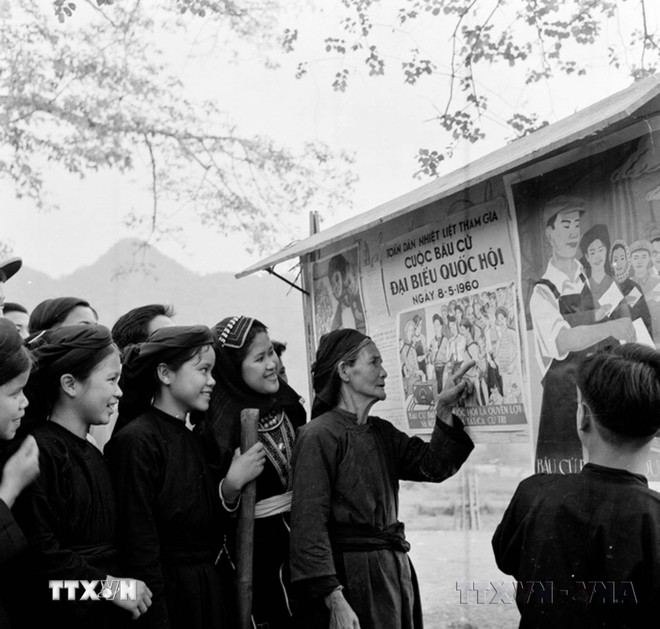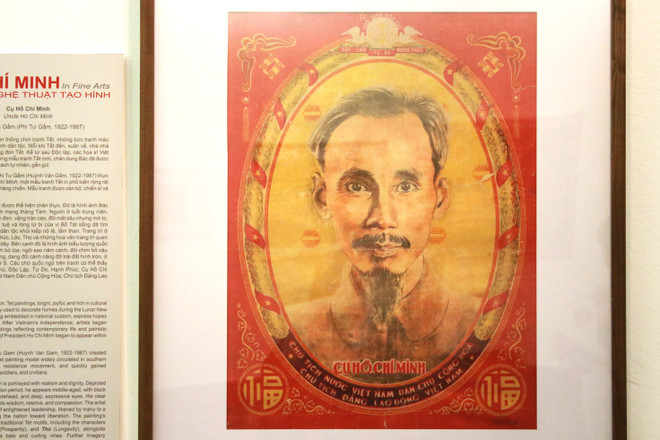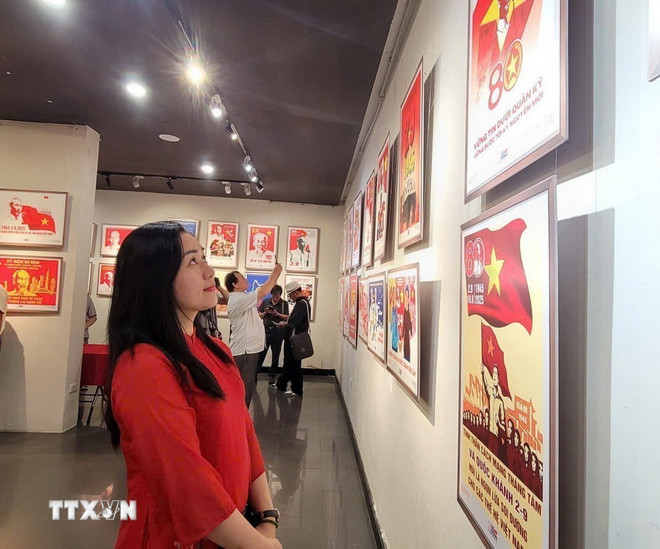Throughout the history of Vietnam's revolution, propaganda paintings have not only been a unique visual art genre but also a sharp spiritual "weapon", contributing effectively to the work of propaganda and mass mobilization.
Despite many changes of the times, propaganda paintings still hold a special position in the flow of modern Vietnamese fine arts.
When art goes hand in hand with history
Propaganda paintings are a graphic genre in the visual arts, with its own characteristics in terms of expressive language. Images, colors, lines, and words in paintings are often generalized, symbolized, or typified, in order to convey propaganda messages about events and social activities associated with each historical period.
Propaganda paintings were formed and developed strongly from the early years of the revolution, especially during the two resistance wars against French colonialism and American imperialism.
Amidst the hardships of bombs and bullets, the quickly drawn, hand-printed, and posted pictures on all roads became vivid visual propaganda channels, spreading revolutionary fire, encouraging the fighting, production, and learning spirit of our army and people.
Not elaborate, not abstract, the propaganda posters use clear shapes, strong colors and short, concise messages to convey key contents such as "Not a pound of rice is missing, not a soldier is missing," "Victory is certain to be ours," "All for the front line," "Riding on the victory of the Winter-Spring campaign to attack the American invaders," "Keep the homeland, keep the youth," "Three ready," "Under one flag," "For the independence, freedom and happiness of the country, the Party calls - we are ready"...

It is this simplicity and directness that makes propaganda paintings accessible, easy to understand and touch people's hearts. Many famous artists in the resistance war against the French such as Nguyen Do Cung, Luong Xuan Nhi, To Ngoc Van, Nguyen Sang, Mai Van Hien, Tran Huy Oanh... devoted their hearts and many years of creation and attachment to this genre.
During the resistance war against America, propaganda paintings contributed significantly to helping people overcome countless difficulties and hardships, stay resilient in the face of bombs and bullets to reach final victory.
Many typical artists associated with propaganda paintings during this period include: Duong Ngoc Canh, Do Xuan Doan, Nguyen Bich, Tran Gia Bich, Nguyen Tien Chung, Pham Van Don...
Not only stopping at propaganda value, propaganda paintings are also a unique mark of 20th century Vietnamese fine arts. It is a combination of graphic art, folk colors and socialist realism expressions, creating a very unique style.
From a cultural-historical perspective, propaganda paintings are valuable documents for research on life, social psychology, political orientation and community aesthetics in each period.
Each painting is a “slice” of time – reflecting the atmosphere, slogans, characters and central goals of the country in each historical period. Many works have gone beyond mere propaganda to become cultural icons.
According to artist Trinh Ba Quat, Head of the Graphics Association, Vietnam Fine Arts Association, artists who create this type of painting are not only visual artists, but also soldiers on the ideological front, carrying the mission of conveying political and social messages quickly, effectively, and deeply to the public.
According to the Chairman of the Vietnam Fine Arts Association, Luong Xuan Doan, Vietnamese propaganda paintings are the fastest "combat" type in any situation. Sometimes, in just a moment, the image appears and the artists immediately start working on it.

In the past, most of them drew by hand, even the letters were hand-drawn. Later, thanks to the support of technology, the implementation was faster, but the spirit of "quick action" was always the characteristic.
The COVID-19 pandemic is a clear testament to the vitality of propaganda posters. After just one night, the next morning, many posters appeared on the streets of Hanoi, arousing faith and hope among the people.
That shows that the language of propaganda posters is always rich and diverse, the most important thing is to find typical images to convey content and ideas in a focused and effective way.
Need "new breath" for propaganda posters
Entering the period of innovation and integration, propaganda posters gradually appear less on the streets as well as in the mass media. However, their role is still maintained in community communication campaigns such as: environmental protection, disease prevention, traffic safety, new rural construction, etc.
The question is, how can propaganda posters continue to be effective in a context where the public is increasingly attracted to social networks and digital media?
According to many researchers, the answer lies in the innovation of form while still maintaining the inherent characteristics. Today's propaganda posters need to be more modern in terms of materials, printing techniques, and graphic design, but still have to adhere to the core spirit: conveying a clear message, having the power to spread and evoking positive emotions.
Artists of the later generation such as Trinh Ba Quat, Pham Binh Dinh, Tran Duc Loi, Nguyen Cong Quang, Nguyen Ngan, Le The Am… were early in approaching innovation, being dynamic and sensitive to trends.
They express the image in the painting by the harmonious combination of main and supporting characters with highly generalized layout and text blocks. They draw by hand and by machine with the desire to create impressive and convincing messages for viewers.

Some young artists such as Do Trung Kien, Ha Thi Huong Thanh, Do Manh Hung, Nguyen Anh Minh, Pham Hong Thanh... have begun to rediscover the language of propaganda paintings, bringing a contemporary breath to propaganda paintings about the environment, traffic culture, public behavior... in a youthful, creative style, easily accessible to young people.
According to the Chairman of the Vietnam Fine Arts Association, Luong Xuan Doan, propaganda posters have never lost their role. Propaganda is needed in every era, from resolutions, bringing policies into life to serving major events of the country.
It can be said that this is a type of art that lives forever with time. “I believe that propaganda posters are always full of vitality, changing through many generations but still attractive to artists, including young artists today,” emphasized the Chairman of the Vietnam Fine Arts Association.
Nowadays, many museums, traditional galleries and private collectors preserve propaganda paintings as a precious heritage. Exhibitions of propaganda paintings from traditional to modern held at the Vietnam Fine Arts Museum, the 16 Ngo Quyen Exhibition House or the International Exhibition on Propaganda Graphics… are proof of the enduring vitality of this genre.
At the same time, the inclusion of propaganda posters in art education programs, graphic design or public spaces is also being proposed as a way to extend the ideological-artistic source from previous generations to today's generation.
Inheriting and renewing propaganda paintings is not only preserving the art form, but also preserving a part of national history in the contemporary cultural flow./.
Source: https://www.vietnamplus.vn/ke-thua-va-lam-moi-tranh-co-dong-trong-dong-chay-van-hoa-post1058996.vnp



![[Photo] National Assembly Chairman Tran Thanh Man receives Cambodian Senate President Hun Sen](https://vphoto.vietnam.vn/thumb/1200x675/vietnam/resource/IMAGE/2025/9/1/7a90c9b1c1484321bbb0fadceef6559b)
![[Photo] People eagerly wait all night for the parade on the morning of September 2](https://vphoto.vietnam.vn/thumb/1200x675/vietnam/resource/IMAGE/2025/9/1/0cf8423e8a4e454094f0bace35c9a392)
![[Photo] Chu Dau Ceramics – Proud of Vietnamese identity at Exhibition A80](https://vphoto.vietnam.vn/thumb/1200x675/vietnam/resource/IMAGE/2025/9/1/c62ab2fc69664657b3f03bea2c59c90e)
![[Photo] Celebration of the 65th Anniversary of the Establishment of Diplomatic Relations between Vietnam and Cuba](https://vphoto.vietnam.vn/thumb/1200x675/vietnam/resource/IMAGE/2025/9/1/0ed159f3f19344e497ab652956b15cca)
![[Photo] Solemn reception to celebrate the 80th anniversary of the National Day of the Socialist Republic of Vietnam](https://vphoto.vietnam.vn/thumb/1200x675/vietnam/resource/IMAGE/2025/9/1/e86d78396477453cbfab255db1e2bdb1)
![[Photo] General Secretary receives heads of political party delegations from countries attending the 80th anniversary of our country's National Day](https://vphoto.vietnam.vn/thumb/1200x675/vietnam/resource/IMAGE/2025/9/1/ad0cb56026294afcae85480562c2e790)











































































![[Infographic] A week of strong fluctuations, gold prices continuously set historical peaks](https://vphoto.vietnam.vn/thumb/402x226/vietnam/resource/IMAGE/2025/9/1/1520fa24c9c94c39afee9a58ceb09de1)



















Comment (0)